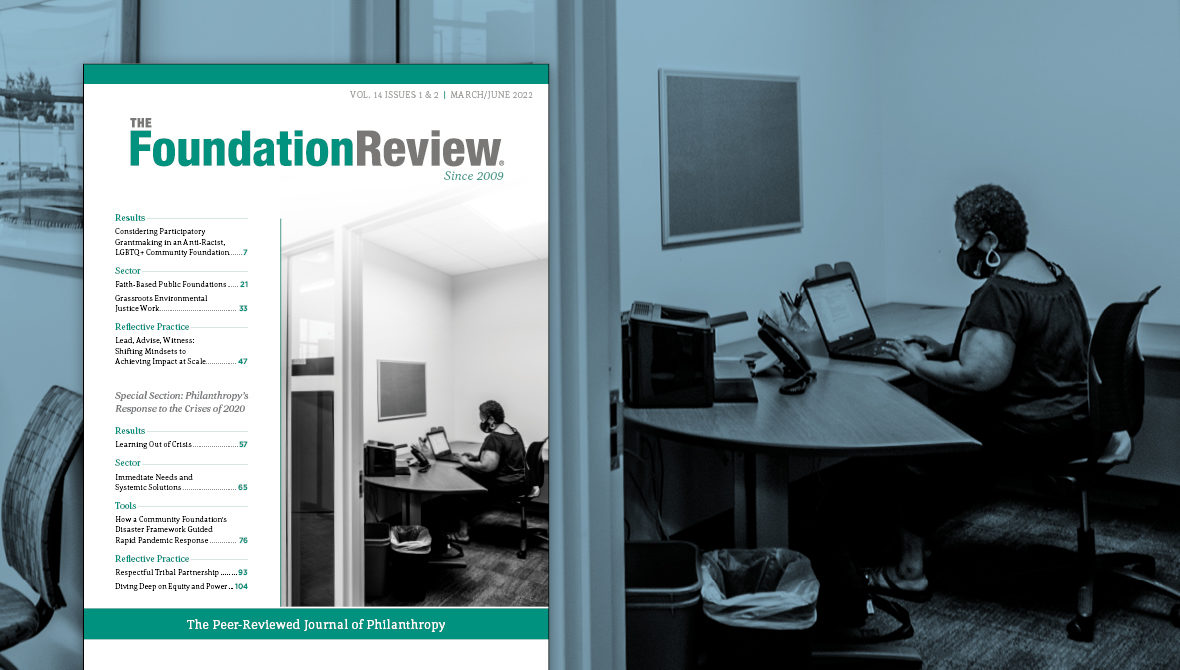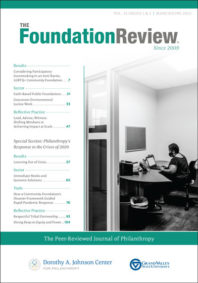Philanthropy’s Response to the Crises of 2020


 The first two issues of Volume 14 of The Foundation Review have been combined and published together, as the impact of COVID-19 on authors and reviewers continued to be a challenge to timelines.
The first two issues of Volume 14 of The Foundation Review have been combined and published together, as the impact of COVID-19 on authors and reviewers continued to be a challenge to timelines.
Issue 1 is an unthemed issue, while Issue 2, presented as a special section, addresses how foundations responded to the public health and social justice crises of 2020 and their continued impact. In case you need to be reminded of the impact of the pandemic, our cover photo captures the feeling of those early days.
In an era of accelerating climate change and social divisiveness, it is more important than ever that foundations have intellectual, ethical, and practical frameworks to guide their actions. The articles in this combined issue offer some valuable places to start.
In this article, Dale and Plastino examine how two major philanthropic paradigms, participatory grantmaking and trust-based philanthropy, were applied by a regional LGBTQ+ funder as part of a broader commitment to social justice. This case study describes the importance of the right staffing, clear communication, community participation, clarity on funding restrictions, and overall organizational readiness to implementing these new approaches.
While faith traditions play a key role in shaping philanthropy for many individuals, Ralph, Fulton, and Allen examine how they are related to giving by public foundations. They analyzed Form 990 data and estimated that 24% of all public charities operate as foundations and that 17% of public foundations are faith-based. This article provides an approach for scholars to analyze relationships between religion and philanthropy and may help nonprofits identify funders who share a similar orientation toward religion.
Ramirez, Baptista, Greenberg, Perovich, Yulsman, Lopez, and Rosenberg conducted a landscape study of environmental funders and grassroots environmental justice organizations in the Gulf South and the Midwest. The foundations they studied awarded the bulk of their environmental funding to mainstream organizations and a small fraction to grassroots environmental justice groups. This article offers specific strategies and opportunities for funders to address the misalignments between funders and these grassroots organizations. The impacts of climate change are becoming more apparent every day and these grassroots organizations are at ground zero in communities that are most affected.
As program staff at the David and Lucile Packard Foundation, Sunshine and Sangalang have had an opportunity to work on Starting Smart and Strong, a 10-year, place-based initiative in three California communities, to develop and test solutions for school readiness. Seven years in, the authors offer key insights into their experiences and how their approach to scaling impact has shifted over the course of the strategy. The scaling of interventions is often driven by foundations. As with designing programs, bringing them to scale is best accomplished by listening deeply to communities and honoring how they define scale. Building on systems built by community members resulted in creative, locally-owned solutions to achieve impact.
One of the foundation practices that had to adapt during the crises of 2020 was evaluation. Cherner explores how the Jim Joseph Foundation modified its learning plans to take advantage of the “forced experimentation” imposed by the pandemic. As the lockdown began in March 2020, the foundation paused ongoing research and evaluation projects and crafted new learning questions and plans to take advantage of the opportunities in the moment. It redeployed resources to assess how the internal foundation team responded to the crisis, how grantees pivoted to online programming, and how the crisis and online programming were experienced by target populations. This case study provides an example of how to use evaluation as a management tool in a time of crisis.
In this article, Perez-Bode Dedecker and Blaschak describe how a group of more than 60 foundations came together in Western New York to collectively respond to the COVID-19 crisis. Rather than responding only to immediate needs, they also wanted to innovate and strengthen the region’s ability to face the future. A “request for ideas” sought out visionary concepts from nonprofit leaders that were collaborative, included multiple sectors, and addressed persistent challenges by centering race and lived experience. Grants were awarded to develop concepts in housing and homelessness, health equity, education, arts and culture, substance use disorders, criminal justice, digital literacy, and refugee services. This ongoing work exemplifies using the crises as an opportunity to change systems to achieve more equitable outcomes.
Mumford, Barrios, and Chavez Greene share the experience of the Greater New Orleans Foundation in responding to the concurrent disasters of 2020. Through its experience with Hurricane Katrina and subsequent disasters in the region, the foundation developed a flexible disaster framework that emphasizes four broad principles — resilience, sustainability, civic participation, and equity. This article describes how the foundation is applying that framework to respond to COVID-19 and concurrent disasters in ways that mitigate immediate harms while laying the groundwork for an equitable long-term recovery.
The COVID-19 pandemic had a disparately harsh impact on Indigenous peoples, with U.S. death rates far higher for Native Americans than for the white population. Effective collaboration with these communities must be based on respecting the leadership and values of the Navajo Nation. In this article, Petersen, Chief, Massaro, Tulley, Tulley-Cordova, and Vold describe an effort to ensure clean water, building on honor and respect for the Diné — “The People” — as the Navajo call themselves. This model can be replicated by funders working with multiple experts, agencies, and governments to promote equity and justice in any philanthropic venture.
Taddy-Sandino, Ammann Howard, and Nascimento provide a model for funders to confront systemic racism by examining the practices, policies, structures, mindsets, and cultural norms that govern how foundations operate. The California Endowment and the James Irvine Foundation used the iconic iceberg model as a tool to deeply explore eight tangible, equity-focused changes in the way they practice philanthropy. Here, the authors reflect on what it takes to shift norms, structures, and power in ways that lead to equitable outcomes and embed equity throughout an organization.
Not yet a subscriber to The Foundation Review?
Click here to start your free 90-day trial!